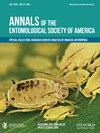巴西埃马斯国家公园塞拉多生态系统中生物发光甲虫的数量、生态学特征及其减少
IF 1.8
3区 农林科学
Q1 ENTOMOLOGY
引用次数: 0
摘要
在巴西生物发光鞘翅目最丰富的生态系统中,塞拉多热带稀树草原是受农业扩张威胁最大的生态系统。Emas (PNE)和Chapada dos guimar本文章由计算机程序翻译,如有差异,请以英文原文为准。
Inventory and ecological aspects of bioluminescent beetles in the Cerrado ecosystem and its decline around Emas National Park (Brazil)
Abstract Among the richest ecosystems in bioluminescent Coleoptera in Brazil, the Cerrado (savannas) is the most threatened one by agricultural expansion. The Emas (PNE) and Chapada dos Guimarães (PNCG) National parks are 2 of the last main remnants of the original Cerrado ecosystems in Central-west Brazil. During the past 3 decades, we have conducted several expeditions to collect, observe and study bioluminescent beetles occurring in the PNE and surrounding farms. More recently we also started to investigate the PNCG. We recorded a total of 51 bioluminescent species, including fireflies (n = 29), click beetles (n = 11), phengodids (n = 10), and staphylinids (n = 1). The PNE region was the richest one, especially for phengodids (n = 9). Among the habitats that compose the Cerrado physiognomy, the Cerrado and cerradão hosted most of the bioluminescent species, followed by forest, open fields and marshes. Most fireflies inhabiting the Cerrado ecosystem emit yellow-green light, whereas most click beetles emit predominantly green light, and among phengodid species, orange and red-light emission was found in 3 species. The spectacular click beetle Pyrearinus termitilluminans Costa-lodging luminous termite mounds were found in PNE and also reported for the first time at PNCG. In the farms around the PNE, however, a declining number of bioluminescent species was recorded in cerradão areas after the replacement of the surrounding cattle pastures by sugarcane plantations, especially adult phengodid males that were no longer attracted to light traps. Habitat reduction, use of agricultural pesticides and artificial night lighting are thought to be the major causes of such impact on bioluminescent beetle diversity.
求助全文
通过发布文献求助,成功后即可免费获取论文全文。
去求助
来源期刊
CiteScore
4.90
自引率
0.00%
发文量
25
审稿时长
6-12 weeks
期刊介绍:
The Annals of the Entomological Society of America exists to stimulate interdisciplinary dialogue across the entomological disciplines and to advance cooperative interaction among diverse groups of entomologists. It seeks to attract and publish cutting-edge research, reviews, collections of articles on a common topic of broad interest, and discussion of topics with national or international importance. We especially welcome articles covering developing areas of research, controversial issues or debate, and topics of importance to society. Manuscripts that are primarily reports of new species, methodology, pest management, or the biology of single species generally will be referred to other journals of the ESA. The most important criteria for acceptance are quality of work and breadth of interest to the readership.

 求助内容:
求助内容: 应助结果提醒方式:
应助结果提醒方式:


